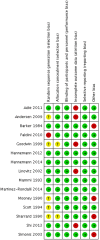Efficacy of Electrical Stimulators for Bone Healing: A Meta-Analysis of Randomized Sham-Controlled Trials
- PMID: 27539550
- PMCID: PMC4990885
- DOI: 10.1038/srep31724
Efficacy of Electrical Stimulators for Bone Healing: A Meta-Analysis of Randomized Sham-Controlled Trials
Abstract
Electrical stimulation is a common adjunct used to promote bone healing; its efficacy, however, remains uncertain. We conducted a meta-analysis of randomized sham-controlled trials to establish the efficacy of electrical stimulation for bone healing. We identified all trials randomizing patients to electrical or sham stimulation for bone healing. Outcomes were pain relief, functional improvement, and radiographic nonunion. Two reviewers assessed eligibility and risk of bias, performed data extraction, and rated the quality of the evidence. Fifteen trials met our inclusion criteria. Moderate quality evidence from 4 trials found that stimulation produced a significant improvement in pain (mean difference (MD) on 100-millimeter visual analogue scale = -7.7 mm; 95% CI -13.92 to -1.43; p = 0.02). Two trials found no difference in functional outcome (MD = -0.88; 95% CI -6.63 to 4.87; p = 0.76). Moderate quality evidence from 15 trials found that stimulation reduced radiographic nonunion rates by 35% (95% CI 19% to 47%; number needed to treat = 7; p < 0.01). Patients treated with electrical stimulation as an adjunct for bone healing have less pain and are at reduced risk for radiographic nonunion; functional outcome data are limited and requires increased focus in future trials.
Conflict of interest statement
MB has received honorariums from Smith & Nephew, Stryker, Amgen, Zimmer, Moximed, Bioventus, Merck, Eli Lilly, Sanofi and research grants from Smith & Nephew, DePuy, Eli Lily, Bioventus, Stryker, Zimmer, Amgen; JWB was a co-principal investigator for a recently completed trial of a competing device (low intensity pulsed ultrasound) that received funding from an industry sponsor (Smith & Nephew); no other relationships or activities have influenced the submitted work.
Figures






References
Publication types
MeSH terms
LinkOut - more resources
Full Text Sources
Other Literature Sources
Medical
Molecular Biology Databases
Miscellaneous

